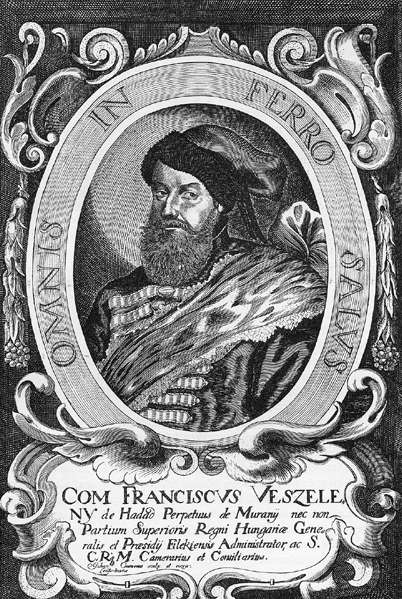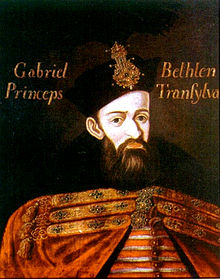HUNGARY.
Laszlo IV of Hungary.
"Laszlo IV favoured his Cuman concubines over his wife and he imprisoned a papal legate who came to excommunicate him in 1279. The voivode of Transylvania forced him to reconcile and the Cumans revolted, so Laszlo defeated them in battle in 1282 and they left. A civil war ended when the Mongols raided in 1284 and some claimed Laszlo invited them into Hungary to help him regain power. He was eventually excommunicated for arresting his wife so he could live with his Cuman mistress, Edua. The Cumans would service their revenge, eventually murdering him." (Clash of Thrones)
Ferenc Wesselényi de Hadad et Murány (1605-1667)
Hungarian military commander and Palatine of the Royal Hungary.
 |
| Ferenc Wesselényi @Wikipedia |
Hungarian military commander and Palatine of the Royal Hungary.
Son of István Wesselényi, royal court counselor of King Ferdinand II of Austria.
Husband of
1.
2. Zsófia Bosnyák
3. Mária Széchy
"Francis Wesselenyi was the Palatine of Hungary, the first man of the kingdom. He was descended from one of the oldest Hungarian houses, which traces its line up to St. Stephen of Hungary. One of his ancestors, as early as the fifteenth century, had held the dignity of palatine of the kingdom, and was one of the first batch of the knights of the Burgundian Golden Fleece. The palatine was a wealthy and jovial man, and had proved his valour in the Turkish war. His wife, the voluptuous, heroic Maria Szetsi, had a principal share in the alleged conspiracy which was prepared against Austria; but she paid very dearly for her adulterous love for her husband's secretary, Francis Nagy, of Lesseny, who rewarded her favours by betraying her to the cabinet of Vienna." (Memoirs of the Court and Aristocracy of Austria, Vol 2: 22)
"After learning of her husband's adultery with his future third wife, Mária Széchy, his second wife, Zsófia Bosnyák, became unhappy and always spent her nights praying in their castle's chapel. She soon became sick and died at the age of 35." (Wikipedia)
His lover was:
Mária Széchy.
Husband of
1.
2. Zsófia Bosnyák
3. Mária Széchy
"Francis Wesselenyi was the Palatine of Hungary, the first man of the kingdom. He was descended from one of the oldest Hungarian houses, which traces its line up to St. Stephen of Hungary. One of his ancestors, as early as the fifteenth century, had held the dignity of palatine of the kingdom, and was one of the first batch of the knights of the Burgundian Golden Fleece. The palatine was a wealthy and jovial man, and had proved his valour in the Turkish war. His wife, the voluptuous, heroic Maria Szetsi, had a principal share in the alleged conspiracy which was prepared against Austria; but she paid very dearly for her adulterous love for her husband's secretary, Francis Nagy, of Lesseny, who rewarded her favours by betraying her to the cabinet of Vienna." (Memoirs of the Court and Aristocracy of Austria, Vol 2: 22)
"After learning of her husband's adultery with his future third wife, Mária Széchy, his second wife, Zsófia Bosnyák, became unhappy and always spent her nights praying in their castle's chapel. She soon became sick and died at the age of 35." (Wikipedia)
His lover was:
Mária Széchy.
 |
| Gabor Bethlen |
Gabor Bethlen of Hungary (1580-1629).
Husband of:
1. ????
2. Katharina von Brandenburg married in 1626.
1. ????
2. Katharina von Brandenburg married in 1626.
His lover was:
Unnamed mistress:
Now you see them, now you don't: ". . . Yet is was not only Catherine who had lovers, for the lover affairs of Bethlen also seem to have been well known. According to the official record of the Bavarian delegates at the wedding, the groom was forced to send away his twelve concubines, for had he not done so, the princess would not have appeared at the wedding. . . The source recorded the malicious remarks made by Hungarian lords that he would soon take them back. During their marriage, the Swedish ambassador reported on Gabriel's numerous flirtations love affairs, and concubines. Gabriel also spoke openly about his active sex life. . . . " (The Rule of Women in Early Modern Europe: 84)
 |
| Istvan Csaky |
Istvan Csaky (1603-1662)
Husband of:
1. Maria Perenyi
2. Krisztina Mindszenti
3. Eva Forgach de Ghymes et Gacs.
His lover was:
"...There were many rumors concerning Catherine's affairs during their marriage; after Bethlen's death, the rumors continued to circulate; it was said that Catherine (Katharina von Brandenburg) had an affair first with a Moravian nobleman, then with her doctor. Her long relationships with Count Istvan Csaky (1602-62), a married man, was common knowledge. Csaky was elegant, the same age as Catherine, and according to common opinion, the best-looking Hungarian at the time. Moreover, he was education and spoke excellent German." (The Rule of Women in Early Modern Europe: 84)
"Gyulafehérvár, 1629. Catherine of Brandenburg, the young wife of the prince is flirting with the married István Csáky, notorious for his seductions, while the rest of the palace is anxiously expecting the arrival of the mortally sick Gábor Bethlen. The old prince arrives on the litter-throne carried by his escort. In his last will, Gábor Bethlen appoints a task to György Rákóczi which is incompatible with the principles of the nobleman, and Rákóczi leaves, denying the errand. For the sake of the unity of Transylvania, Bethlen speaks a few words on behalf of Catherine. When he is left alone at last, he dies peacefully, praying to God. His soul is united with the eternally loving soul of Anna Báthory in heavens. Catherine of Brandenburg is intimidated by the obligations of ruling a country, and runs away with István Csáky - thus it happens that the aristocracy offers the throne of Transylvania to György Rákóczi." (Magda Gyori)
"It would seem that adulterous sexual relationships with married women were so safe that they were very rarely recorded. The most famous case from the seventeenth century, however, that of Istvan Csaky, a relative of the Istvan Csaky mentioned earlier, became common knowledge. He was known by his contemporaries as the lover of Prince Gabor Bethlen's second wife, Katherine of Brandenburg. Even Csaky's mother, Anna Wesselenyi, hinted at the fact in her letters. Csaky and Katherine had no children." (Peter, 2001, pp. 49-50)
 |
| Jozsef Rakoczi Tolnai-korabeli kep alapjan, 1910 |
Jozsef Rakoczi (1700-1738).
Duke of Munkacs 1734
Marchese di San Marco 1723.
His lover was:
NN.
[Fam1:GeneAll]
Margit Thyssen-Bornemisza.
Her lovers were:
1) Joachim Oldenburg.
"Meanwhile Margit remained at the castle, where she was provided with a generous allowance from Thyssengas, one of her father's German companies. A Thyssengas employee and Nazi Party member, Joachim Oldenburg, was seconded to assist in managing the estate. Locals employed at Rechnitz report that the 'young dashing and virile' Oldenburg quickly accepted responsibility for accompanying Margit on hunting trips -- and was soon sharing her bed. This despite the fact that, in 1933, Margit had enhanced her social position by marrying an impoverished Count Ivan Batthyany, whose family had originally owned the town of Rechnitz and a large slice of Hungary. In a bizarre arrangement, while the 'countess' shared the castle with her SS guests and her bed with Joachim Oldenburg, her estranged husband continued to enjoy his wife's money and breed horses on one of the Batthyany's adjoining Hungarian estates" (Independent)
"Meanwhile Margit remained at the castle, where she was provided with a generous allowance from Thyssengas, one of her father's German companies. A Thyssengas employee and Nazi Party member, Joachim Oldenburg, was seconded to assist in managing the estate. Locals employed at Rechnitz report that the 'young dashing and virile' Oldenburg quickly accepted responsibility for accompanying Margit on hunting trips -- and was soon sharing her bed. This despite the fact that, in 1933, Margit had enhanced her social position by marrying an impoverished Count Ivan Batthyany, whose family had originally owned the town of Rechnitz and a large slice of Hungary. In a bizarre arrangement, while the 'countess' shared the castle with her SS guests and her bed with Joachim Oldenburg, her estranged husband continued to enjoy his wife's money and breed horses on one of the Batthyany's adjoining Hungarian estates" (Independent)
2) Franz Podezin.
"Further complicating her domestic arrangements, Margit was also enjoying a dalliance with the sexually ambitious Franz Podezin, a Gestapo administrator and leader of the Rechnitz Nazi Party. |
| Miklos III, Prince Esterhazy |
Miklos II, Prince Esterhazy von Galantha (1765-1833)
Husband of:
Maria Josepha von Liechtenstein, mar 1783.
"...From Eisenstadt castle Nicholas II indulged his love of collecting. He collected snail shells, medals, and minerals, all of which were put on display... But his greatest achievement was his magnificent collection of paintings and engravings...But there was another side to Prince Nicholas. His mania for collecting spread to women. He kept numerous mistresses, dotted about western Hungary, each in her own house, and visited them all in turn. He had a marked appetite for young girls, which his entourage did its best to hush up...." (Walker, 1987, p. 43)
"...From Eisenstadt castle Nicholas II indulged his love of collecting. He collected snail shells, medals, and minerals, all of which were put on display... But his greatest achievement was his magnificent collection of paintings and engravings...But there was another side to Prince Nicholas. His mania for collecting spread to women. He kept numerous mistresses, dotted about western Hungary, each in her own house, and visited them all in turn. He had a marked appetite for young girls, which his entourage did its best to hush up...." (Walker, 1987, p. 43)
"According to Mraz (2009), Nikolaus was known 'for his debauched lifestyle, keeping what amounted to a private brothel in the Landstraße'. One commentator said that he had 200 mistresses and fathered 100 illegitimate children." (Wikipedia)
| Pal II Antal Prince Esterhazy von Galantha |
1) Harriette Wilson.
2) Teresa Vestris (1726-1808)
Italian dancer.
" . . . While performing in Vienna she became the mistress of Prince Esterhazy, a liaison which prompted a jealous Empress Maria Theresa to order the dancer's immediate transfer to Dresden. . . ." (Craine & Mackrell: 472), References: [Ref1]
 |
| Thomas Preljubovic & Maria Palaiologina |
Thomas Preljubovic (d.1384)
Despot of Epirus 1366-1384
Despot of Epirus 1366-1384
Son of: Gregorius Preljub, Serbian Governor of Thessaly & Irene of Serbia.
Wife of: Maria Angelina Doukaina Palaiologina (1350-1394), mar 1366, Queen of Epirus 1384-1385.
Daughter of: Stephen Uros, Emperor of Serbia & Thomais Orsini.
His lover was:
His lover was:
Unnamed mistress.
Natural offspring:
a.Irene (d.1374/75) mar John Losha of Arta.
BOHEMIA.
.jpg) |
| Ottokar II of Bohemia |
Ottokar II of Bohemia (1233-1278).
King of Bohemia 1253.
His lovers were:
1) Agnes von Kuenring.
2) Palczierzik.

